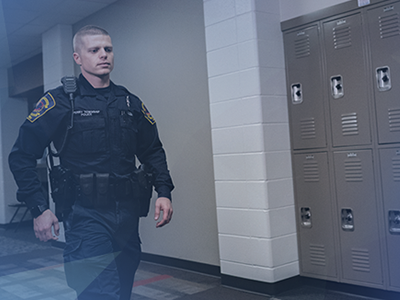Reinforcing Our Culture of Safety: How AstraZeneca Launched Mass Communications as a Force Multiplier
Customer Success Story
Reinforcing Our Culture of Safety: How AstraZeneca Launched Mass Communications as a Force Multiplier


James Lee,
Site Security and Emergency Response Manager
AstraZeneca
Industry
Challenges Solved
Customer Details
With 13 facilities in the United States, AstraZeneca’s Gaithersburg, Maryland complex serves as the pharmaceutical company’s primary North American hub. 4,000 employees work in the 10 building research and manufacturing complex.
Solution
As a leading pharmaceutical company, AstraZeneca is a 24/7 operation. Our research and manufacturing facilities work around the clock to bring cutting-edge medicines to patients worldwide. Interruptions to our lab activities and production processes can cause lost research and production delays, directly impacting people who need our therapies.
There is no margin of error, so efficient incident response is a top priority.
The Hub At Our Gaithersburg Campus
AstraZeneca has 13 sites in the US. Our primary North American hub is our Gaithersburg, MD, complex, comprising 10 buildings with 1.5 million square feet of administrative, research, and manufacturing space. It is home to 4,000 employees pushing the boundaries of medicine by exploring target biology, protein engineering, translational science, personalized healthcare, and biopharmaceutical and clinical development. Our pilot plant pioneers the production of pharmaceuticals that address chronic illnesses and life-threatening ailments. We also have an on campus childcare facility, a gym, and recreational facilities.
This hive of activity is monitored and protected by a team of 40 security professionals operating out of a state-of-the-art command center. We are a forward-focused customer-serving group that manages access control, oversees video security, and answers email and phone calls from employees and visitors alike. A supervisor guides our procedural protocols and a dedicated site manager is responsible for security staff on behalf of our service provider, Allied Universal.
As the Gaithersburg security and emergency response manager, I oversee our contracted security services team and supervise the day-to-day operations of our command center. I work closely with Brooks Cucuel, our director of regional security for the Americas, who was previously in charge of security and business resilience here at Gaithersburg.
Together, we co-manage AstraZeneca’s US-wide enterprise access control system. We also led the transformation of our campus emergency response program. We have transitioned from paper based security procedures to a full-fledged digital system that offers advanced alerts and robust two-way communications. Our new digital approach puts the right information in the hands of the right people at the right time.
Improving Emergency Management In Our Command Center
Our command center was Brooks’ brainchild and absolutely a step in the right direction, and we wanted to build on that in a few different ways to improve emergency management:
- Our Voice over Internet Protocol (VoIP) system sent email notifications to the security management team whenever someone dialed 9-1-1. Assessing the authenticity of emergency calls required significant time and effort, which we wanted to reduce.
- We had more than 30 printed emergency contact lists with calling trees for different types of emergencies, everything from power outages to fires. We’d call the numbers to alert the appropriate parties individually, hoping people would pick up the phone.
- We used an alert messaging system to notify our business continuity and crisis management teams, but it required complex configuration to ensure messages reached the right people and the platform training was lengthy.
- During one power outage, Brooks’ controllers were going through their calling trees as usual, and Brooks was simultaneously receiving calls from our executive team asking for updates. We wanted to move faster, and in 2017, Brooks replaced our previous system with Rave Alert, a Motorola Solutions technology.
The Rave Alert Pilot
We started by migrating our 30-plus calling lists into Rave Alert templates, making sure to update people and departments in the process. Because response rates for texts are much higher than phone calls, we also set up a list of email and text message triggers so we could supplement or replace voice alerts with today’s most preferred methods of communication.
Some departments had specific notification requests for team members, and Rave Alert is flexible enough that we could make these requests with a push of a button. We also found it helpful that we could restrict notifications based on time of day, building or shift. For example, we didn’t want to bother night shift managers and employees if a fire broke out at noon.
We piloted Rave Alert for a year with 300 people, and it was a resounding success. Everyone agreed the command center had established a working system that gave everyone visibility into our emergency response efforts, and the command center team shifted their focus to emergency response instead of worrying about whether notifications reached the right people. We could easily communicate with a facilities technician, a hazardous material specialist, or a shift supervisor. They could update us by providing on-the-ground situational information, and we could update the appropriate parties while also responding to the incident in front of us. Speed and reliability are essential when it comes to effectively managing emergencies, and our new two-way communication loop helped us coordinate more effectively and resolve situations quickly.
Rolling Out Rave Alert Across Campus
One of the reasons we chose Rave Alert was because of its scalability, and after the trial, we rolled out Rave Alert across the entire campus in 2018. The technology allows us to manage multiple communications streams targeting specific buildings and groups within the facility. For example, we can send out a fire alert informing occupants to evacuate one building, while simultaneously notifying the rest of the campus to avoid the affected building. When the situation is resolved, we can send the all-clear to everyone.
Rave Alert also leverages the Common Alerting Protocol (CAP) to forward emergency messages, like tornado warnings, from public authorities to various channels including campus signage. In the past, we had to open an alert template, type in the information, and route it to everyone on campus. Rave Alert automates that process, saving precious time and allowing our emergency teams to dedicate more efforts to preparation.
We made large safety strides over the past five years, and Rave Mobile Safety has helped us as a partner, not just a vendor. We became part of their Customer Advisory Board, and they regularly solicit our feedback and update us on their technology roadmap. We tell them what works and what doesn’t, and they incorporate our input into future releases. In turn, we can plan our deployments to take advantage of features that are in the pipeline.
“Automating emergency notifications saves precious time and allows our emergency teams to dedicate more efforts to preparation.”
JAMES LEE
SITE SECURITY AND EMERGENCY RESPONSE MANAGER
ASTRAZENECA
Digitizing The Incident Response Playbook
During one of my interactions with the Customer Advisory Board, I learned about Rave Collaborate. As the Gaithersburg system administrator, I had already assumed ownership of Rave Alert and digitized our call lists. Rave Collaborate would allow us to digitize our emergency checklists, helping to eliminate human error. When I presented the solution to Brooks, he agreed it met another pressing need.
Rave Collaborate automates the communication of critical information like emergency protocols, assigns critical tasks to the appropriate individuals, and records emergency responses and actions. Rave Collaborate digitizes the playbook and takes our people from A to Z in a crisis. We can track our activities to take the proper steps as the situation unfolds and review the situation to improve next time.
For example, we could ask why it took 10 minutes for security officers to clear the road for firefighters. We can analyze the steps leading up to the delay, review our actions, and retool our processes accordingly.
Our Phones Went Quiet During Emergencies
It used to be that command center phone lines were filled with people asking for updates during a crisis. We had to provide information and clarification while trying to manage the situation, and emergency response managers had to juggle several responsibilities while walking personnel through crisis checklists. Now those actions happen automatically. Our managers can monitor unfolding situations from anywhere, and they don’t have to leave meetings or interrupt their plans when they’re out of the office. Everything runs smoothly, and we’ve reduced the chance of human error because our response teams must check off items as they complete them.
People want things to be black and white, but emergencies can unfold in different ways. It’s easier for people to think on their feet in a crisis if you present them with a clear set of action items or alternatives. With Rave Collaborate, we can create logic-based forks that allow our people to pivot depending on the situation. If an alert is triggered during business hours, they can skip to step seven. If it’s late at night, they should go to step nine. Protocol A applies if the event is at a research lab, and protocol B goes into effect if it’s at the cafeteria building or employee gym.
We analyzed response times before and after deploying Rave solutions. In the event of a power outage, it used to take a command center staffer 12–15 minutes to get through our old call trees and checklists. With Alert and Collaboration, it takes two minutes to update the template and click send. The system will automatically message and email the necessary personnel while generating location-specific and site-wide emergency notifications.
“It’s easier for people to think on their feet in a crisis if you present them with a clear set of action items or alternatives.”
JAMES LEE
SITE SECURITY AND EMERGENCY RESPONSE MANAGER
ASTRAZENECA
What’s Next? A Personal Safety App
Our partnership with Rave Mobile Safety recently led us to AppArmor, the company’s personal safety and notification app that can be customized to our branding. When they presented it to us, we saw it could become a central hub where users could access a variety of information. We get a lot of questions—Where do I go to get a badge? How does a person get a badge? How do I register a visitor? What about parking?—and put all of the answers on our intranet, but people had to search for it. The more we discussed it, the more we thought a Gaithersburg security app would be awesome and offer something nobody else had.
In addition to answers for common questions, we’ll also have details on booking labs and conference rooms and ordering scientific equipment. To top it all off, we’ll add information about special events like Take Your Child to Work Day and CEO Town Halls. Moving important information into the app will essentially put the AstraZeneca portal into every employee’s pocket, making it easier for personnel across our campus to be connected and informed.
Another important feature of our AppArmor tool will be our Lone Worker program. If someone is working alone in a space, they can use the app to notify the command center to check in on them periodically or track them as they walk back to their car. This capability is already built into AppArmor, so there’s no need to code an in-house app. We’re still in the customization and implementation phase of AppArmor and hoping to roll out the mobile safety app in Q3 2023.
We’ve Come A Long Way On Our Safety Journey
Our transformation began with buy-in from our executive team. We engaged end users and stakeholders across campus, and showed them how Rave Alert, Collaborate, and AppArmor addressed our needs while fitting in with our corporate culture and values. You can’t launch large-scale initiatives like these and trust that people will adapt to something new. You must first understand expectations and demonstrate the value of these new approaches, bringing everyone on board.
We’ve also learned that a good partner is critical throughout this process. It can be hard to engage directly with safety and security vendors, but Rave emphasized partnership from day one. When they release a new feature, they ensure it works and help us make everything right. They elicit feedback and have adjusted their road map and tweaked product features to meet our needs.
Using a great set of solutions, Brooks and I have launched mass communications as a force multiplier at AstraZeneca’s Gaithersburg campus. We have improved our response posture by communicating timely incident information to our leadership team and all relevant stakeholders. We resolve situations faster because we are no longer managing phone calls or clearing up miscommunications. We have improved in-the moment decision-making, put everyone on the same page, and set up a region-wide backend so we can replicate this success at our other North American facilities. Our security and emergency response infrastructure is on par with a global brand like ours—and our department and our employees are better for it.
“We have improved our response posture by communicating timely incident information to our leadership team and all relevant stakeholders.”
JAMES LEE
SITE SECURITY AND EMERGENCY RESPONSE MANAGER
ASTRAZENECA
More From Rave Mobile Safety
Talk With An Expert
Discover our prepackaged solutions or configure a package that’s right for your community, company, K-12 schools and higher education system. Learn how you can be up and running in days, take advantage of unlimited emergency usage, and benefit from unbeatable performance and customer satisfaction.




